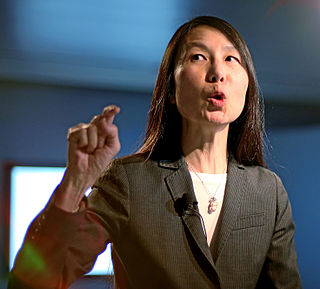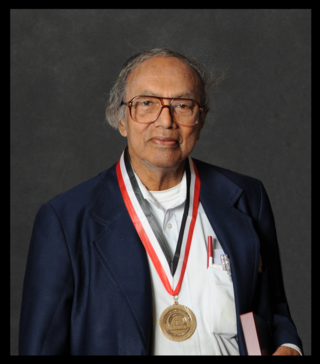
In computer science and operations research, the ant colony optimization algorithm (ACO) is a probabilistic technique for solving computational problems which can be reduced to finding good paths through graphs. Artificial ants stand for multi-agent methods inspired by the behavior of real ants. The pheromone-based communication of biological ants is often the predominant paradigm used. Combinations of artificial ants and local search algorithms have become a method of choice for numerous optimization tasks involving some sort of graph, e.g., vehicle routing and internet routing.

Kornelis Antonie "Kees" Schouhamer Immink is a Dutch engineer, inventor, and entrepreneur, who pioneered and advanced the era of digital audio, video, and data recording, including popular digital media such as compact disc (CD), DVD and Blu-ray disc. He has been a prolific and influential engineer, who holds more than 1100 U.S. and international patents. A large portion of the commonly used audio and video playback and recording devices use technologies based on his work. His contributions to coding systems assisted the digital video and audio revolution, by enabling reliable data storage at information densities previously unattainable.
Software visualization or software visualisation refers to the visualization of information of and related to software systems—either the architecture of its source code or metrics of their runtime behavior—and their development process by means of static, interactive or animated 2-D or 3-D visual representations of their structure, execution, behavior, and evolution.
Vasant G. Honavar is an Indian-American computer scientist, and artificial intelligence, machine learning, big data, data science, causal inference, knowledge representation, bioinformatics and health informatics researcher and professor.

Jeannette Marie Wing is Avanessians Director of the Data Science Institute at Columbia University, where she is also a professor of computer science. Until June 30, 2017, she was Corporate Vice President of Microsoft Research with oversight of its core research laboratories around the world and Microsoft Research Connections. Prior to 2013, she was the President's Professor of Computer Science at Carnegie Mellon University, Pittsburgh, Pennsylvania, United States. She also served as assistant director for Computer and Information Science and Engineering at the NSF from 2007 to 2010. She was appointed the Columbia University executive vice president for research in 2021.
In software engineering, software aging is the tendency for software to fail or cause a system failure after running continuously for a certain time, or because of ongoing changes in systems surrounding the software. Software aging has several causes, including the inability of old software to adapt to changing needs or changing technology platforms, and the tendency of software patches to introduce further errors. As the software gets older it becomes less well-suited to its purpose and will eventually stop functioning as it should. Rebooting or reinstalling the software can act as a short-term fix. A proactive fault management method to deal with the software aging incident is software rejuvenation. This method can be classified as an environment diversity technique that usually is implemented through software rejuvenation agents (SRA).
Design science research (DSR) is a research paradigm focusing on the development and validation of prescriptive knowledge in information science. Herbert Simon distinguished the natural sciences, concerned with explaining how things are, from design sciences which are concerned with how things ought to be, that is, with devising artifacts to attain goals. Design science research methodology (DSRM) refers to the research methodologies associated with this paradigm. It spans the methodologies of several research disciplines, for example information technology, which offers specific guidelines for evaluation and iteration within research projects.

Robert Jackson Marks II is an American electrical engineer, computer scientist and Distinguished Professor at Baylor University. His contributions include the Zhao-Atlas-Marks (ZAM) time-frequency distribution in the field of signal processing, the Cheung–Marks theorem in Shannon sampling theory and the Papoulis-Marks-Cheung (PMC) approach in multidimensional sampling. He was instrumental in the defining of the field of computational intelligence and co-edited the first book using computational intelligence in the title. A Christian and an old earth creationist, he is a subject of the 2008 pro-intelligent design motion picture, Expelled: No Intelligence Allowed.
Virgil Dorin Gligor is a Romanian-American professor of electrical and computer engineering who specializes in the research of network security and applied cryptography.
Jock D. Mackinlay is an American information visualization expert and Vice President of Research and Design at Tableau Software. With Stuart Card, George G. Robertson and others he invented a number of information visualization techniques.

Vijay K. Bhargava is a researcher and Professor in the Department of Electrical and Computer Engineering at the University of British Columbia (UBC). He served the department as its Head for 5 years. Before moving to UBC, Bhargava was a Professor in the Department of Electrical and Computer Engineering at University of Victoria.
Colette Rolland is a French computer scientist and Professor of Computer Science in the department of Mathematics and Informatics at the University of Paris 1 Pantheon-Sorbonne, and a leading researcher in the area of information and knowledge systems, known for her work on meta-modeling, particularly goal modelling and situational method engineering.
Metadatabase is a database model for (1) metadata management, (2) global query of independent databases, and (3) distributed data processing. The word metadatabase is an addition to the dictionary. Originally, metadata was only a common term referring simply to "data about data", such as tags, keywords, and markup headers. However, in this technology, the concept of metadata is extended to also include such data and knowledge representation as information models, application logic, and analytic models. In the case of analytic models, it is also referred to as a Modelbase.
Software intelligence is insight into the inner workings and structural condition of software assets produced by software designed to analyze database structure, software framework and source code to better understand and control complex software systems in information technology environments. Similarly to business intelligence (BI), software intelligence is produced by a set of software tools and techniques for the mining of data and the software's inner-structure. Results are automatically produced and feed a knowledge base containing technical documentation and blueprints of the innerworking of applications, and make it available to all to be used by business and software stakeholders to make informed decisions, measure the efficiency of software development organizations, communicate about the software health, prevent software catastrophes.

Chittoor V. Ramamoorthy (1926–2016) was an Indian-American computer scientist, computer engineer and educator whose work had many implications in engineering, computer science, and software engineering. Together with Raymond T. Yeh, he is given credit for the early establishment of the discipline of software engineering. He had a large following worldwide with whom he actively collaborated until the last few months of his life. Advances made during these collaborations included the exploration of transdisciplinary methods and the development of a science to support future complex systems design.
This glossary of artificial intelligence is a list of definitions of terms and concepts relevant to the study of artificial intelligence, its sub-disciplines, and related fields. Related glossaries include Glossary of computer science, Glossary of robotics, and Glossary of machine vision.
Arun K. Somani is Associate Dean for Research of College of Engineering, Distinguished Professor of Electrical and Computer Engineering and Philip and Virginia Sproul Professor at Iowa State University. Somani is Elected Fellow of Institute of Electrical and Electronics Engineers (IEEE) for “contributions to theory and applications of computer networks” from 1999 to 2017 and Life Fellow of IEEE since 2018. He is Distinguished Engineer of Association for Computing Machinery(ACM) and Elected Fellow of The American Association for the Advancement of Science(AAAS).






